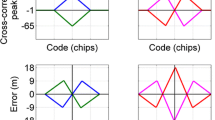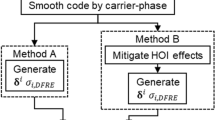Abstract
Doppler collision has a very important issue in satellite-based navigation systems. Navigation with the Indian Constellation (NavIC) comprises seven operational satellites, among which three are geo-stationary (GEO) satellites, and the rest are geosynchronous satellites. Due to the 'small line of sight velocities' of GEO satellites, estimated ranges suffer from the unique challenge of Doppler collision (DC). In this study, we present an analysis of DC events in both static and dynamic conditions, particularly in aerospace applications. We utilize experimental data acquired from the Indian Regional Navigation Satellite System (IRNSS)-GPS-Satellite Based Augmentation System (SBAS) (IGS) receiver located at a low altitude station to develop algorithms for the prediction, avoidance, and mitigation of DC events. The prediction of DC is based on the moving average method. We have devised an efficient algorithm to avoid the occurrence of DC, considering all possible combinations of IRNSS GEO satellites. Additionally, we perform the mitigation of DC using a proposed hybrid approach that involves both the space segment and user segment. The approach is based on repositioning the IRNSS 1C satellite and varying the loop bandwidth of the Delay Locked Loop (DLL). With the implementation of this proposed hybrid approach, the time duration of DC is reduced by 59.16% in static conditions and 16% in dynamic conditions.



















Similar content being viewed by others
Data availability
Data sharing not applicable to this article as no datasets were generated or analyzed during the current study.
References
Kaplan GH New Technology for Celestial Navigation. In: Proc. Nautical almanac office sesquicentennial symposium U.S. Naval Observatory, March 3–4, 1999
Ansari K, Bae TS, Seok HW, Kim MS. Multi constellation global navigation satellite systems signal analysis over the Asia Pacific region. In: International Journal of Satellite Communications and Networking, 2021, 39 (3), 280–293
Ansari K, Park KD (2018) Multi constellation GNSS precise point positioning and prediction of propagation errors using singular spectrum analysis. Astrophysics Space Science 363 (258)
Sarma AD, Sultana Q, Satya Srinivas V (2010) Augmentation of Indian regional navigation satellite system to improve dilution of precision. J Navigation 63 (2).
Sathish P, Reddy DK, Sarma AD (2016) Preliminary Performance evaluation of IRNSS-GPS-SBAS receiver in terms of position accuracy and velocity. In: International symposium on antennas and propagation (APSYM), Cochin, India, December 15- 17
Mruthyunjaya L, Ramasubramanian R Indian Regional Navigation Satellite System, Signal in Space for Standard Positioning Service Interface Control Document. Version 1.1, 2017, ISRO, India
Kotla SR, Fahmeen S, Sultana Q, Krishna Reddy D (2019) Augmention of NAVIC 11 with Beiduo-3 Over Indian Region. J Adv Res Dyn Control Syst 11(8): 1667–1673
Bhandari V, O’Keefe K (2017) Characterization of Doppler collision and its impact on carrier phase ambiguity resolution using geostationary satellites. GPS Solutions 21(4):1707–1720
Lestarquit L, Malicorne M Correction algorithm for SBAS C/A code interference. In: Proc. ION GNSS, Institute of Navigation, Portland, Oregon, USA, September 9–12, 2003 pp 1345–1354
Glennon EP, Dempster AG Cross Correlation Mitigation Techniques for Software GPS C/A Code Receivers. IGNSS Symposium on GPS/GNSS, Sydney, Australia. December 4–6, 2007
Balaei AT, Akos DM (2011) Cross correlation Impacts and observations in GNSS receivers. Navigation, 58(4): 323–333.
Bhandari V (2015) Characterization of Doppler collision and Its Effect on Indoor Positioning. In: Proc. of the international conference on indoor positioning and indoor navigation (IPIN 2015), October 13–16 , Banff, Canada
Balaei AT, Akos DM Doppler collision and cross correlation interference in GPS receivers. In: Proc. of the International global navigation satellite systems society, holiday Inn Surfers Paradise, Qld, Australia, December 1–3,2009
Holt CC (2004) Forecasting seasonals and trends by exponentially weighted moving Averages. Int J Forecasting 20(1): 5–10.
Lestarquit L, Collet S Tracking error correction algorithm in case of quasi-stationary C/A code interference. In: Proc. ION GPS 2000, Institute of Navigation, Salt Lake City, Utah, USA, September 19–22, 2000, pp 2323–2329
Lestarquit L, Malicorne M Correction algorithm for SBAS C/A code interference. In: Proc. ION GNSS, Institute of Navigation, Portland, Oregon, USA, September 9–12, 2003, pp 1345–1354
Kim E, Walter T, Powell JD Adaptive carrier smoothing using code and carrier divergence. In: Proc. ION NTM 2007, January 22–24, 2007 San Diego, California, USA, pp 141–152
Cox DT, Shallberg KW (1999) Manz A definition and analysis of WAAS receiver multipath error envelopes. Navigation 46(4):271–282
Cao F, Yang X, ZhiGang L et.al “Orbit determination and prediction of GEO satellite of BeiDuo during repositiong Maneuver” Advances in Space Research 2014, 54(2014), pp.1828–1837
Acknowledgements
The research work was carried out under the AICTE sponsored research project with Sanction order No: 8-34/FDC/RPS/POLICY-1/2021-22 under the RPS scheme. The authors are thankful to the Space Application Centre (SAC), ISRO Ahmedabad, for providing the IGS Receiver for the establishment of NCRC in CBIT Hyderabad for data acquisition and field trials.
Funding
No funding was received to assist with the preparation of this manuscript.
Author information
Authors and Affiliations
Contributions
PS performed the experiments to analyse Doppler Collision in dynamics conditions, developed the Doppler Collision mitigation techniques for IRNSS 1C-1G satellite pair and wrote paper. DKR performed the mathematical analysis for Doppler Collision in NAVIC system, developed the Doppler Collision mitigation techniques for IRNSS 1C-1G satellite pair and wrote paper. VLK performed the experiments to analyse Doppler Collision in static conditions, developed the Doppler Collision mitigation techniques for IRNSS 1C-1G satellite pair and wrote paper. ADS performed the analysis, validation of the Doppler Collision results in static and dynamic conditions, developed the algorithms for Doppler Collision Prediction and avoidance and wrote the paper.
Corresponding author
Ethics declarations
Conflict of interest
The authors have no conflicts of interest to declare that are relevant to the content of this article.
Rights and permissions
Springer Nature or its licensor (e.g. a society or other partner) holds exclusive rights to this article under a publishing agreement with the author(s) or other rightsholder(s); author self-archiving of the accepted manuscript version of this article is solely governed by the terms of such publishing agreement and applicable law.
About this article
Cite this article
Sathish, P., Reddy, D.K., Kumar, V.L. et al. Doppler collision analysis and mitigation using hybrid approach for NavIC system. AS 6, 677–688 (2023). https://doi.org/10.1007/s42401-023-00251-4
Received:
Revised:
Accepted:
Published:
Issue Date:
DOI: https://doi.org/10.1007/s42401-023-00251-4




